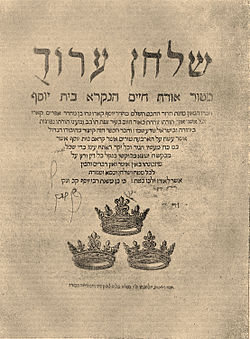
Back شولحان عاروخ Arabic شولحان عاروخ ARZ Şulxan Arux Azerbaijani Шулхан арух Byelorussian Шулхан арух BE-TARASK Шулхан арух Bulgarian Xulhan Arukh Catalan Šulchan aruch Czech Shulchan Arukh Danish Schulchan Aruch German
 | |
| Author | Joseph Karo |
|---|---|
| Language | Hebrew |
| Subject | Halakha |
Publication date | 1565 |
| Publication place | Venice |
| Preceded by | Bet Yosef |
The Shulchan Aruch (Hebrew: שֻׁלְחָן עָרוּך, romanized: šulḥān ʿaruḵ, lit. 'Set Table' [ʃulˈħɔn ʕaˈruχ]),[a] often called "the Code of Jewish Law", is the most widely consulted of the various legal codes in Rabbinic Judaism. It was authored in the city of Safed in what is now Israel by Joseph Karo in 1563 and published in Venice two years later.[1] Together with its commentaries, it is the most widely accepted compilation of halakha or Jewish law ever written.
The halachic rulings in the Shulchan Aruch generally follow Sephardic law and customs, whereas Ashkenazi Jews generally follow the halachic rulings of Moses Isserles, whose glosses to the Shulchan Aruch note where the Sephardic and Ashkenazi customs differ. These glosses are widely referred to as the mappā "tablecloth" to the "Set Table". Almost all published editions of the Shulchan Aruch include this gloss, and the term has come to denote both Karo's work as well as Isserles', with Karo usually referred to as "the Meḥabbēr" (הַמְחַבֵּר, "Author") and Isserles as "the Rema" (a Hebrew acronym of his name).
Due to the increased availability of the printing press, the 16th century was an era of legal codification in the Polish–Lithuanian Commonwealth, the Ottoman Empire, and other countries. Previously unwritten laws and customs were being compiled and recorded; the Shulchan Aruch was one such compilation. In the century after it was published by Karo, whose vision was a unified Judaism under Sephardic traditions, it became the code of law for Ashkenazi Jews together with the later commentaries of Isserles and 17th century Polish rabbis.[2]
Cite error: There are <ref group=lower-alpha> tags or {{efn}} templates on this page, but the references will not show without a {{reflist|group=lower-alpha}} template or {{notelist}} template (see the help page).